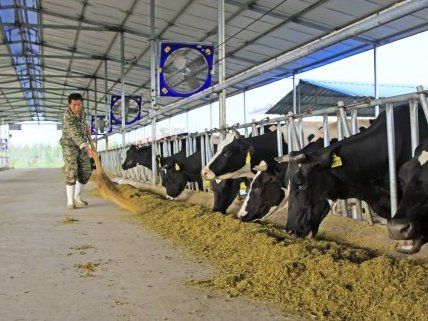China’s increasing demand for milk will have far-reaching consequences for the world
China needs more and more milk. By 2050, milk consumption in China is expected to be triple the current level. The big question is, where will this milk be produced? In China? Or elsewhere? What are the possible scenarios and what are the consequences? A team of researchers from China, Wageningen, New Zealand, the UK and Austria has calculated the effects of this increase in milk consumption on, among others, the international trade in milk and fodder, land use, and emissions of greenhouse gases and nitrogen.

China’s increasing demand for milk will have far-reaching consequences for the world
Wageningen University
The research was led by Lin Ma, who earned his doctorate in Wageningen and now works for the Chinese Academy of Sciences. Wageningen was represented by Gerard Velthof, Oene Oenema and PhD candidate Zhaohai Bai. Fusuo Zhang of China Agricultural University also participated; he will shortly be receiving an honorary doctorate from Wageningen during its 100th anniversary celebrations.
The ever-expanding international trade in agricultural products has had a detrimental effect on land use, nutrient cycles and emissions of greenhouse gases. Today, nearly a quarter of all food that is cultivated for human consumption is traded on the international market. The trade in animal fodder (particularly soya and maize) is responsible for most of the deforestation and decline of biodiversity in the world. Against this background, it is not only important to determine where the milk for China will be produced, but also where the necessary fodder will come from. For example, if China decides to produce all the extra milk they need themselves, their imports of animal fodder will more or less quadruple, while their greenhouse gas emissions will double.
One of the scenarios that the researchers calculated was if 75% of the additionally required milk was produced in China (using the existing production methods) and 25% was imported from Europe, New Zealand and the US. By 2050, the amount of land around the world needed for fodder crops for the dairy industry would have increased by 30%, resulting in an increase in global greenhouse gas emissions of about 35% and increased nitrogen emissions of nearly 50%. If all the additionally required milk was produced outside China, then Europe, New Zealand and the US would need to drastically increase the amount of land under fodder. In Europe, for example, almost 40% more land in the dairy sector would be required for growing animal feed. This amount of land could only be made available by making huge changes to current land use throughout the whole of Europe. Moreover, the emissions of greenhouse gases and nitrogen would increase by a few dozen percent, making it impossible for Europe to meet international environmental agreements.
“In other words, these scenarios are unrealistic,” says Gerard Velthof of Wageningen Environmental Research. “If you want to limit the effects of increased dairy production on the environment and land use as much as possible, you will need to increase the efficiency of milk production in China to the level of world leaders like the Netherlands. This would reduce emissions of greenhouse gases by some 10%, and the amount of land required by 30%. This is a huge challenge, but it is certainly possible. For example, real improvements could be made in grassland management and the management of manure in China. However, even if the efficiency of the dairy industry in China is drastically increased, global emissions of greenhouse gases and nitrogen produced by this sector will still rise by 20 to 25%. The predicted increase in China’s demand for milk will have major global consequences, whatever the scenario.”
Most read news
Other news from the department business & finance

Get the food & beverage industry in your inbox
By submitting this form you agree that LUMITOS AG will send you the newsletter(s) selected above by email. Your data will not be passed on to third parties. Your data will be stored and processed in accordance with our data protection regulations. LUMITOS may contact you by email for the purpose of advertising or market and opinion surveys. You can revoke your consent at any time without giving reasons to LUMITOS AG, Ernst-Augustin-Str. 2, 12489 Berlin, Germany or by e-mail at revoke@lumitos.com with effect for the future. In addition, each email contains a link to unsubscribe from the corresponding newsletter.





















































